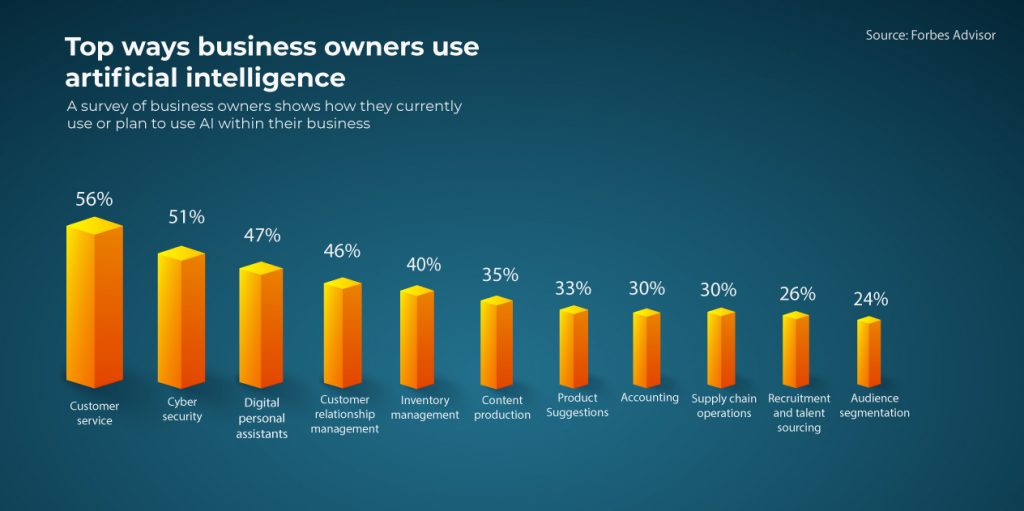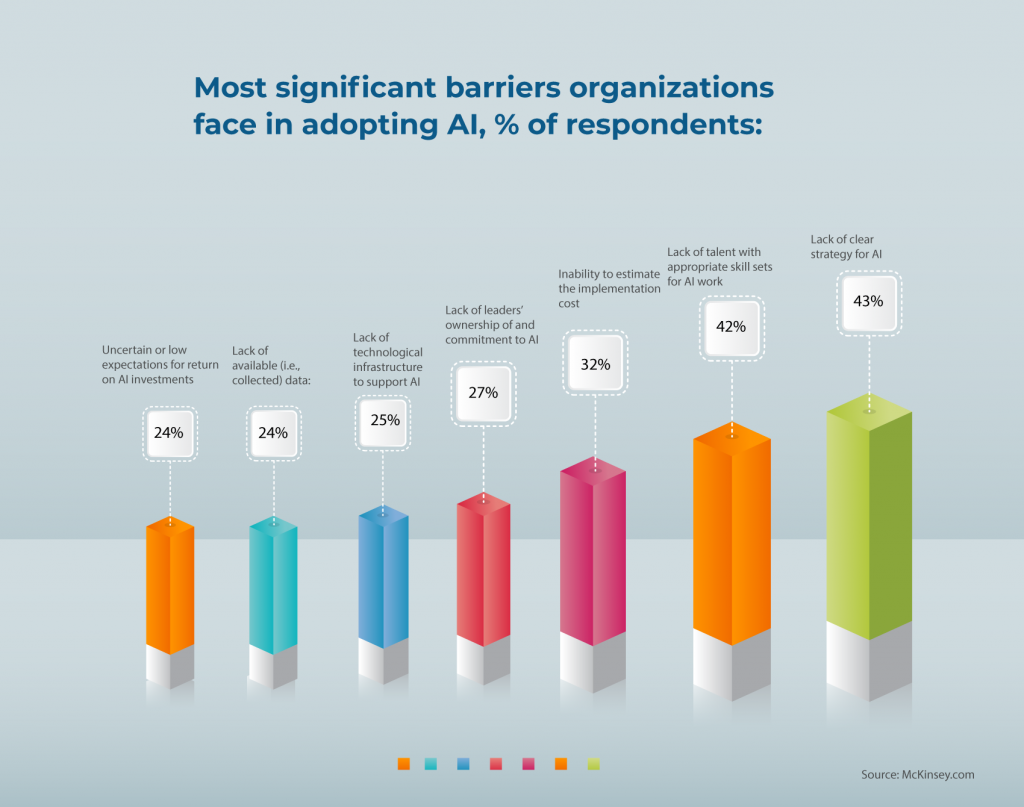
27 Oct Common challenges that businesses face in AI adoption and how to overcome them
Challenges faced by businesses in AI adoption
The adoption of Artificial intelligence (AI) across business sectors has seen an upward trend in the recent times. AIs provide with the ability to automate activities, improve decision-making, and providing a competitive advantage, and better customer experience. However, it is critical to be aware of the challenges that businesses face while adopting AIs into their infrastructure.
The visible application of AI are around us with the likes of Siri, Alexa, etc. that are getting increasingly integral for daily lives. And the recent buzz around generative AI driven by the simplicity for creating high-quality text, graphics, and videos in a matter of seconds has taken over the world and certainly the interests of businesses. A survey by Forbes says that almost 97% business owners believe that ChatGPT will help their business. Thus, businesses need crystal clear understanding of adopting AI and the challenges it possess.
Is your business AI-ready?
In a world where adaptability is key, AI becomes the catalyst for your organization to not only survive but thrive in the ever-changing business domain. Find out if your organization is ready or not for AI, with our AI readiness assessment and identify the shortcomings to create a successful AI adoption roadmap and implementation strategy. To assess click!
Significance of AI adoption for business growth
AI is no longer an optional tool; it’s a necessity for businesses aiming to thrive in the digital age. Here’s why AI adoption is crucial for business growth:
Efficiency
AI automates repetitive and time-consuming tasks, allowing employees to focus on more strategic activities. This improved efficiency directly impacts productivity and operational costs.
Data-driven decision making
AI analyzes vast amounts of data in real-time, offering insights that humans may overlook. Informed decision-making leads to better strategies and outcomes.
Enhanced customer experiences
AI-powered personalization and chatbots provide customers with tailored experiences, boosting satisfaction and loyalty.
Innovation
AI accelerates innovation by automating routine tasks and freeing up resources for research and development.

Common challenges in AI adoption
Lack of expertise and skill
AI adoption demands specialized knowledge and skills that many organizations lack. Without the necessary expertise, businesses may struggle to implement AI effectively, limiting their ability to benefit from it. Investing in training with relevant skills can empower the resources to manage and adapt to the changes.
Data quality and availability
AI relies heavily on data, making data quality and availability pivotal. Many businesses either lack the necessary data or have poor-quality data unsuitable for AI applications. Inaccurate or insufficient data can lead to incorrect conclusions and, consequently, misguided strategies. Using sufficient amount of high quality and well-optimized data with better data management helps in building effective AI models.
Integration with legacy systems
Legacy systems that are incompatible with AI technology can be challenging to integrate. The process is often complex and time-consuming. Hindered integration with existing systems can lead to inefficiencies and increased costs. Modernizing the systems with efficient operational framework and cutting-edge technologies can ease AI adoptions.
Implementation cost
Implementing AI can be expensive, particularly for small and medium-sized businesses. The cost includes acquiring and training AI models, as well as the necessary hardware and software. High initial costs may deter businesses from exploring AI adoption, limiting their competitiveness. The solution is to understand that though a bit costly it may seem, AI adoption makes the life easier and maximizes the benefits with a array of AI tools.
Right infrastructure availability for AI
Implementing AI into the organization requires the support of right technological infrastructure and architecture in place. So the leadership should plan accordingly and set up the required technological advancements so that the AI implementation is smooth and requires minimal support.
Lack of leader’s ownership
Leaders should have a clear understanding and ownership of the type of technology being deployed in their organization, what business problem or process is addressed, what the risks are and what datasets are being used. As flawed data sets give errored results that may harm the business.
Regulatory and ethical concerns
AI technology raises ethical and regulatory concerns, especially regarding data privacy, bias, and transparency. Non-compliance with regulations can lead to legal issues and reputational damage. Ethical concerns may also deter customer trust. Keeping up to date on all regulations, implementing safeguards, involving legal and ethics experts, with responsible and ethical data utilization can alleviate the concerns.
Low expectations on the ROIs
Some organizations may be resistant to change and may not fully comprehend the value of AI technology and its return of investment. Without having an idea of the costs involved and its future returns it limit the organization’s ability to harness the benefits of AI. It is important to estimate the potential business value and implement AI accordingly to get the expected ROI.

How businesses can adopt AI successfully
Businesses can harness the full potential of AI with the following ways:
Start small: acquire skill and experience
Begin with manageable AI projects that align with your business goals. Starting small allows you to learn, adapt and build the skills without overwhelming your organization. As you gain expertise and experience, you can gradually expand your AI initiatives.
Data strategy
Develop a clear strategy for data collection, management, and security. High-quality data is the lifeblood of AI. Ensure that you have processes in place for data acquisition, cleaning, and storage. Strong data governance is essential.
Continuous learning and training
Invest in training and development programs to upskill your existing workforce in AI technologies. Building AI competency within your organization ensures that you have the talent to drive your AI initiatives.
A progressive leadership with tech ownership
As responsible leaders, it is imperative to understand the technology to identify specific requirements of the business to build the needed solution. It is observed that the tendency of organizations to adopt AI as a solution, without fully comprehending the problem, is high. The leaders should have the knowledge of what is needed and what technology is being used to implement to carry out a smooth AI adoption process.
Transparency is key
In the intricate world of AI, clarity is very important:
- Open communication: demystify AI by explaining how algorithms work. Transparency builds trust and understanding.
- Ethical use: prioritize ethical data collection and usage, ensuring that you adhere to relevant regulations.
- Feedback channels: establish avenues for users to voice concerns and provide feedback, fostering trust and improvement.
Collaboration with AI experts
Collaboration is the key to unlocking AI’s full potential:
- Collaborate with tech teams and AI specialists who bring domain expertise. External expertise can provide invaluable insights.
- Ensure AI tools are correctly integrated into strategies and processes.
- Consulting with external AI experts can offer fresh perspectives and insights.
Successful AI integration strategies
Here are the steps to successfully integrate AI technology into your infrastructure:
Step 1: Discovery
Begin with a comprehensive discovery phase. Identify your business priorities, it capabilities, and the most critical problems AI can solve. This phase lays the foundation for your AI initiatives.
Step 2: Create a reference architecture for MLOPs
A well-defined reference architecture guides technology selection and ensures you have the infrastructure to support your AI projects. It also helps in operationalizing AI solutions effectively.
Step 3: Identify partners and vendors
Identify vendors and tools that align with your reference architecture. Assess their pros and cons, cost, features, and alignment with your organization’s goals. Prioritize procurement based on project requirements.
Step 4: Consider personnel and organizational changes
Identify gaps in skills and competencies within your organization. Decide whether to develop these skills internally or outsource specific AI-related tasks. Ensure alignment with leadership on investment in skill development.
Step 5: Monitor and evaluate performance
To ensure that your AI initiatives are delivering the right results, it is important to regularly monitor and evaluate their performance against your predefined objectives. This will help you identify any areas of improvement and optimize your AI solutions to achieve even better results.
Step 6: Foster a culture of continuous learning
Maintaining a competitive edge in the continuously expanding field of artificial intelligence requires keeping up with the most recent advancements. Promote a culture of continuous growth among your team members and fund training and development initiatives. In turn, this might help your company in keeping a competitive advantage in the market.
Step 7: Outsource AI
Collaborate with AI experts who can guide you through the adoption process and assist in overcoming technical challenges. Outsourcing can be a cost-effective way to access AI capabilities without building them in-house.
Conclusion:
In the dynamic landscape of AI adoption, challenges are the stepping stones to innovation. At Nuvento, we not only acknowledge the hurdles, we help you leap over them. Our AI Readiness Assessment is your compass in this AI-driven business environment. It’s designed to not only assess your organization’s readiness for AI adoption but to illuminate the path forward.
By evaluating your organization across six crucial pillars, we uncover the gaps, reveal the potential, and shed light on the necessary steps for a successful AI journey. Challenges in AI adoption can be conquered with the right strategy and insights, and that’s exactly what Nuvento’s evaluation brings to the table. Ready to tailor AI to your business? Request a consultation with our AI specialists by
